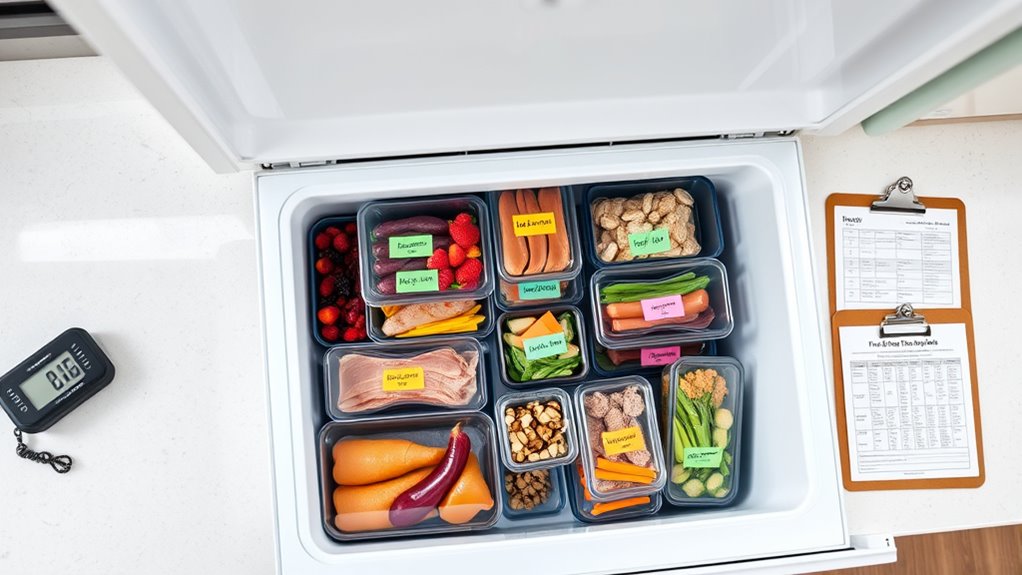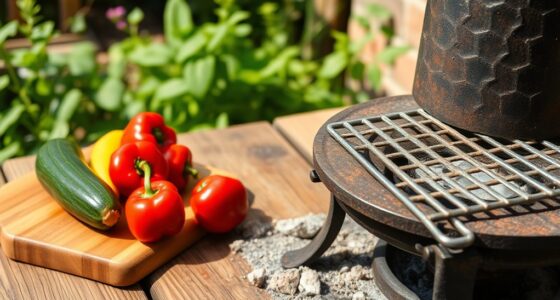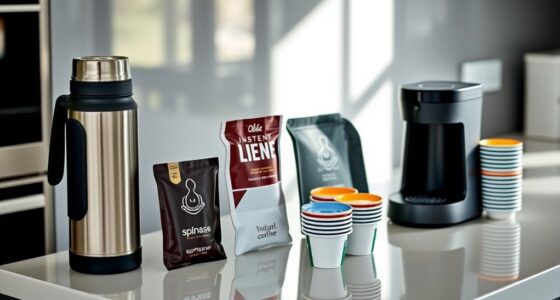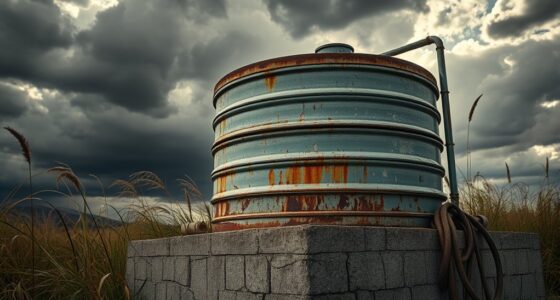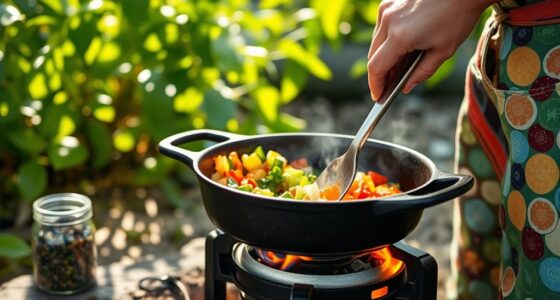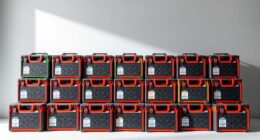To effectively plan your freezer food safety, you need to stick to recommended storage times, such as 1 year for poultry and 3-6 months for seafood, and keep your freezer at 0°F or lower. Use proper thawing methods like refrigeration or cold water, and organize your items by type and dates. Monitoring temperatures and managing your inventory helps prevent spoilage and foodborne illnesses. If you continue exploring, you’ll discover more tips to keep your food safe and fresh longer.
Key Takeaways
- Maintain freezer temperature at 0°F (-18°C) to ensure food safety and quality over recommended storage periods.
- Follow specific time windows for different foods: poultry (1 year), seafood (3-6 months), cooked leftovers (3-4 months), beef (1 year).
- Properly thaw foods using refrigeration, cold water, or microwave methods, avoiding room temperature to prevent bacterial growth.
- Regularly check and organize stored items by type and expiration date to minimize waste and ensure timely use.
- Label frozen items with dates to track storage duration and prevent prolonged freezing that can compromise safety and quality.
Essential Guidelines for Freezer Food Safety and Thawing
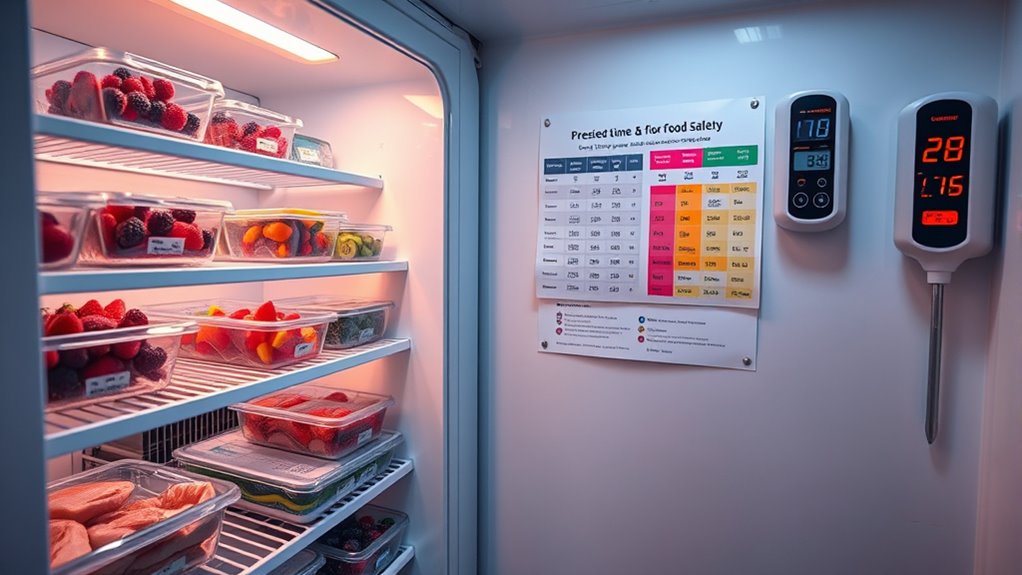
Freezing your food is an effective way to preserve its freshness and prevent spoilage, but only if you follow proper safety guidelines. One of the most critical aspects is understanding how to handle thawing safely. Thawing safety involves more than just leaving food out at room temperature; it requires precise methods to prevent bacterial growth. The key is to plan ahead and use safe thawing techniques such as refrigeration, cold water baths, or microwave defrosting. Each method has its own time window and safety precautions, but the common goal is to keep the food at safe temperatures during the process. For example, when you thaw food in the refrigerator, ensure the storage temperature stays below 40°F (4°C). This temperature range slows bacterial growth, preventing pathogens from multiplying rapidly. Never leave perishable items out on the counter for extended periods, as that creates an ideal environment for bacteria to flourish, risking foodborne illnesses.
Maintaining proper storage temperature is fundamental to freezer food safety. Your freezer should be set consistently at 0°F (-18°C) or lower to keep food safe indefinitely, but that doesn’t mean you can ignore how long food stays in there. Different foods have recommended storage time windows. For instance, raw meats like poultry should be used within a year for *maximum* quality, while cooked leftovers are best consumed within 3 to 4 months. Keeping your freezer at the right temperature ensures that food remains frozen and prevents thawing and refreezing cycles, which can compromise safety and texture. When you plan your storage, organize foods by type and use-by dates so you can prioritize what to consume first. Regularly check your freezer’s temperature with an appliance thermometer to ensure it stays consistent. Proper deforestation impacts and environmental considerations highlight the importance of sustainable practices in food storage and handling.
Another critical aspect of freezer food safety time windows is knowing how long foods can safely remain frozen without significant quality loss. Even if food remains safe beyond these windows, its texture and flavor might deteriorate. For example, seafood typically maintains good quality for about 3 to 6 months, while beef can last up to a year. Understanding these guidelines helps you manage your inventory better, reducing waste and ensuring you consume foods at their peak safety and quality. Always label and date your frozen items, so you know their age at a glance. By paying close attention to thawing safety, storage temperature, and recommended time windows, you can enjoy your frozen foods without worry, confident that you’re following best practices for safe and delicious meals.
Frequently Asked Questions
How Can I Tell if Frozen Food Has Been Stored Too Long?
You can tell if frozen food has been stored too long by checking its storage duration and observing thawing methods. If it’s past the recommended time, like 3-6 months for meats, it might be unsafe. Also, if the food shows freezer burn, ice crystals, or a strange odor after thawing, it’s a sign it’s gone too long. Rely on these signs to guarantee your food stays safe and fresh.
Are There Differences in Safety Guidelines for Commercial vs. Home Freezers?
Did you know that nearly 60% of foodborne illnesses are linked to improper storage? When it comes to safety guidelines, there are notable differences between commercial storage and home freezers. Commercial freezers typically have larger capacities and stricter temperature controls, often maintained at -18°C (0°F), whereas home freezers may vary. Always follow specific guidelines for each setting to guarantee your food remains safe and retains quality.
What Are the Signs of Freezer Burn That Affect Food Safety?
You’ll notice freezer burn signs like dry, leathery patches and food discoloration, which can affect food quality but not necessarily safety. Freezer burn results from moisture loss, leading to texture changes and potential flavor loss. While the food remains safe if free from spoilage or bad odors, it’s best to cut away affected areas to enjoy the remaining safe, quality portions. Always inspect for unusual smells or sliminess to guarantee safety.
How Do I Organize My Freezer for Optimal Food Safety?
Picture your freezer as a bustling library, with books (or food) neatly arranged. To guarantee ideal storage and food safety, organize your freezer by grouping similar items, labeling everything clearly, and using storage bins. Keep older items at the front for easy use, and maintain a consistent temperature. This way, you prevent spoilage, reduce waste, and keep your frozen foods safe and easily accessible.
Can Reheating Frozen Food Affect Its Safety and Quality?
Reheating frozen food can affect both its safety and quality if you don’t use proper reheating techniques and temperature control. Always reheat food evenly, using methods like stovetop, oven, or microwave, and make certain it reaches an internal temperature of at least 165°F (74°C). This kills bacteria and prevents foodborne illnesses. Proper temperature control preserves texture and flavor, so don’t rush the process or reheat multiple times.
Conclusion
So, now that you’ve mastered the art of freezer food safety, you’re basically a culinary superhero—armed with timers and labels instead of capes. Just imagine, confidently tossing that questionable chicken or mysterious bag of leftovers into the freezer, knowing they’ll stay perfect forever—well, almost. Remember, without proper planning, your freezer could turn into a time-bomb of spoiled surprises. Stay vigilant, stay safe, and keep those food safety rules in mind—your future self will thank you!
